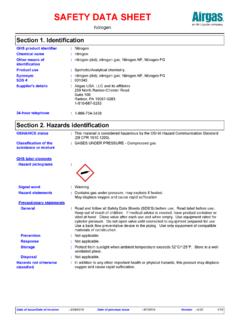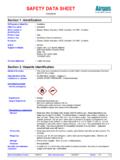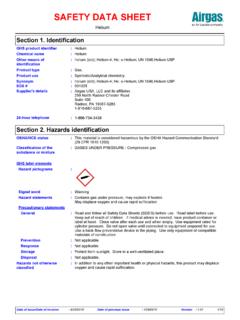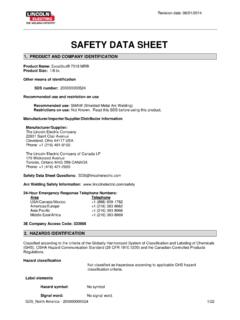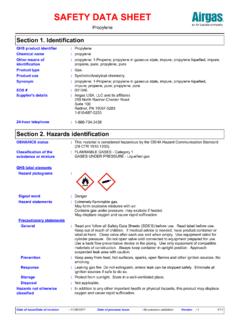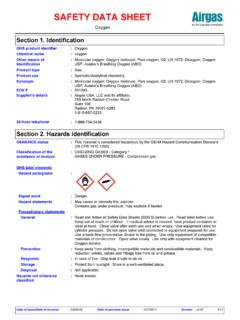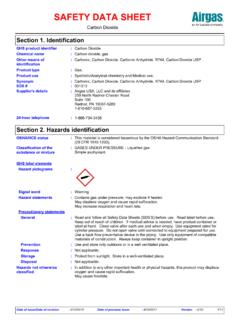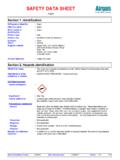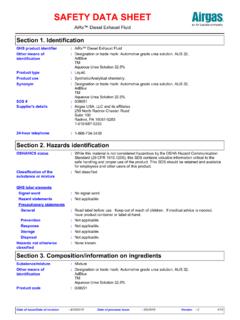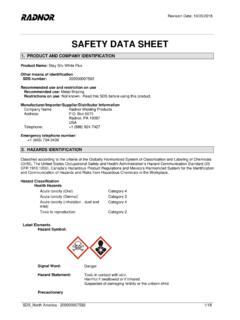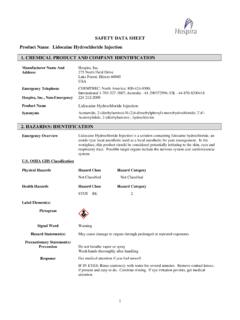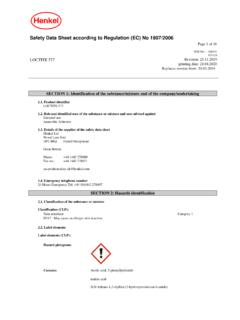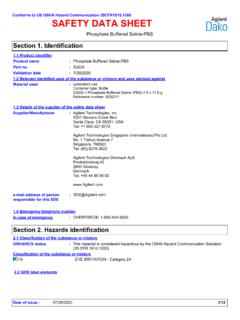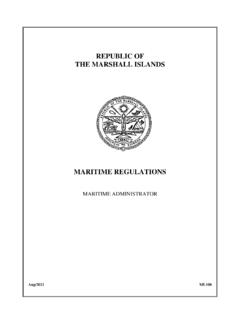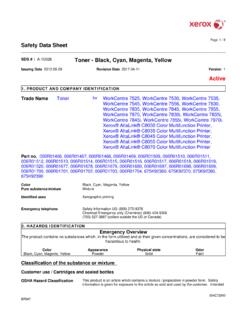Transcription of SAFETY DATA SHEET - Airgas
1 Calcium Chloride, AnhydrousCalcium chloride (CaCl2) SAFETY DATA SHEETGHS product identifierOther means of identificationEmergency telephone number (with hours of operation)Section 1. Identification:::Chemical name :calcium chlorideSupplier's details:Calcium Chloride, AnhydrousProduct use:Synthetic/Analytical USA, LLC and its affiliates259 North Radnor-Chester RoadSuite 100 Radnor, PA 19087-52831-610-687-52531-866-734-3438 SDS #:001087 Synonym:Calcium chloride (CaCl2)Section 2. Hazards identificationSERIOUS EYE DAMAGE/ EYE IRRITATION - Category 2 Classification of the substance or mixture:Signal word:WarningHazard statements:Causes serious eye pictograms:Precautionary statementsPrevention:Wear eye or face protection.
2 Avoid release to the environment. Do not eat, drink or smoke when using this product. Wash hands thoroughly after handling. Use and store only outdoors or in a well ventilated :IF IN EYES: Rinse cautiously with water for several minutes. Remove contact lenses, if present and easy to do. Continue rinsing. If eye irritation persists: Get medical :Not :Not label elementsGeneral:Read label before use. Keep out of reach of children. If medical advice is needed,have product container or label at status:This material is considered hazardous by the OSHA Hazard Communication Standard (29 CFR ).
3 Hazards not otherwise classified:None by IHSDate of issue/Date of revision:5/18 of previous issue:5/18 Chloride, AnhydrousSection 3. Composition/information on ingredientscalcium chloride10010043-52-4 Ingredient nameCAS number%There are no additional ingredients present which, within the current knowledge of the supplier and in the concentrations applicable, are classified as hazardous to health or the environment and hence require reporting in this name :calcium chlorideOther means of identification:Calcium chloride (CaCl2)CAS number:10043-52-4 Substance/mixtureProduct code:001087 CAS number/other identifiers.
4 Occupational exposure limits, if available, are listed in Section out mouth with water. Remove dentures if any. Remove victim to fresh air and keep at rest in a position comfortable for breathing. If material has been swallowed and the exposed person is conscious, give small quantities of water to drink. Stop if the exposed person feels sick as vomiting may be dangerous. Do not induce vomiting unless directed to do so by medical personnel. If vomiting occurs, the head should be kept low so that vomit does not enter the lungs. Get medical attention if adverse health effects persist or are severe.
5 Never give anything by mouth to an unconscious unconscious, place in recovery position and get medical attention an open airway. Loosen tight clothing such as a collar, tie, belt or flush eyes with plenty of water, occasionally lifting the upper and lower eyelids. Check for and remove any contact lenses. Continue to rinse for at least 10 minutes. Get medical contaminated skin with plenty of water. Remove contaminated clothing and shoes. Get medical attention if symptoms occur. Wash clothing before reuse. Clean shoes thoroughly before victim to fresh air and keep at rest in a position comfortable for breathing.
6 If not breathing, if breathing is irregular or if respiratory arrest occurs, provide artificial respiration or oxygen by trained personnel. It may be dangerous to the person providing aid to give mouth-to-mouth resuscitation. Get medical attention if adverse health effects persist or are severe. If unconscious, place in recovery position and get medical attention immediately. Maintain an open airway. Loosen tight clothing such as a collar,tie, belt or 4. First aid measuresEye contactSkin contactInhalationIngestion::::Descriptio n of necessary first aid measuresMost important symptoms/effects, acute and delayedInhalation:No known significant effects or critical to mouth, throat and stomach.
7 :IngestionSkin contact:No known significant effects or critical serious eye irritation.:Eye contactOver-exposure signs/symptomsPotential acute health effectsFrostbite:Try to warm up the frozen tissues and seek medical by IHSDate of issue/Date of revision:5/18 of previous issue:5/18 Chloride, AnhydrousSection 4. First aid measuresProtection of first-aiders:No action shall be taken involving any personal risk or without suitable training. It may be dangerous to the person providing aid to give mouth-to-mouth to physician:Treat symptomatically.
8 Contact poison treatment specialist immediately if large quantities have been ingested or treatments:No specific contactIngestionInhalationNo specific specific specific data.:::Eye contact:Adverse symptoms may include the following:pain or irritationwateringrednessSee toxicological information (Section 11)Indication of immediate medical attention and special treatment needed, if necessarySection 5. Fire-fighting measuresPromptly isolate the scene by removing all persons from the vicinity of the incident if there is a fire. No action shall be taken involving any personal risk or without suitable thermal decomposition productsSpecific hazards arising from the chemicalDecomposition products may include the following materials:halogenated compoundsmetal oxide /oxidesNo specific fire or explosion should wear appropriate protective equipment and self-contained breathing apparatus (SCBA) with a full face-piece operated in positive pressure protective equipment for fire-fightersUse an extinguishing agent suitable for the surrounding media.
9 None extinguishing media:Unsuitable extinguishing media:Special protective actions for fire-fighters:Section 6. Accidental release measuresEnvironmental precautionsPersonal precautions, protective equipment and emergency procedures::No action shall be taken involving any personal risk or without suitable surrounding areas. Keep unnecessary and unprotected personnel from entering. Do not touch or walk through spilled material. Provide adequate appropriate respirator when ventilation is inadequate. Put on appropriate personal protective dispersal of spilled material and runoff and contact with soil, waterways, drains and sewers.
10 Inform the relevant authorities if the product has caused environmental pollution (sewers, waterways, soil or air).For non-emergency personnelFor emergency responders:If specialised clothing is required to deal with the spillage, take note of any information in Section 8 on suitable and unsuitable materials. See also the information in "For non-emergency personnel".Powered by IHSDate of issue/Date of revision:5/18 of previous issue:5/18 Chloride, AnhydrousSection 6. Accidental release measuresMove containers from spill area. Approach release from upwind.
